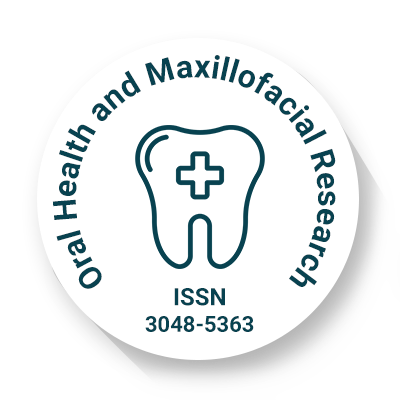
Oral Health and Maxillofacial Research
OPEN ACCESS
ISSN: 3048-5363

OPEN ACCESS
ISSN: 3048-5363
Prosthodontics is a branch of dentistry that focuses on replacing and restoring lost or inadequate teeth together with related maxillofacial tissues. This field includes several different specialities, such as maxillofacial prosthetics, implant prosthodontics, and fixed and removable prosthodontics.
Scope of Prosthodontics
Fixed Prosthodontics: In fixed prosthodontics, damaged or missing teeth are restored with permanent restorations such as crowns, bridges, inlays, and on-lays. Bridges replace one or more missing teeth by securing prosthetic teeth to nearby natural teeth or implants, whereas crowns cover damaged teeth to restore their shape and function. Teeth with moderate decay or damage can be restored using inlays or on-lays, which fit inside or on the tooth's cusps, respectively.
Removable Prosthodontics: Focuses on prosthetics, such as full or partial dentures, that patients may take out and put back in, giving those who have lost several teeth back both function and appearance. Partial dentures fill in the spaces left by missing natural teeth, while complete dentures replace every tooth in an arch. These prostheses are intended to be visually beautiful, pleasant, and useful.
Implant Prosthodontics: Dental implants, which act as prosthetic roots attached to the jawbone to support the crowns, bridges, or dentures, are the major sections of implant prosthodontics. Compared to traditional dentures, implant-supported prostheses provide more stability and operationality, specifically in the lower jaw where bone loss can make it difficult to retain dentures.
Maxillofacial Prosthetics: Focusing on the treatment of individuals who have abnormalities due to illness, accident, or birth defects; this treatment ensures replacing elements of the face or jaw with prosthetics. To restore function and appearance for individuals with complicated craniofacial abnormalities, this treatment requires cooperation with other medical specialists.
Treatment Elements
Prosthodontic therapy is customized to meet the needs of each patient and may consist of:
Crowns: These caps are used to restore the size, form, strength, and appearance of teeth that have been damaged or decaying. Depending on the practical and aesthetic needs, they can be made from a variety of materials, such as metals, ceramics, or an amalgamation of these.
Bridges: Bridges are permanent dental restorations that attach prosthetic teeth to nearby natural teeth or implants to replace one or more lost teeth. Bridges support the preservation of the dental arch's structure and the alignment of the remaining teeth.
Dentures: Complete or partial sets of detachable devices that replace lost teeth and surrounding tissues. Dentures are now more comfortable, useful, and aesthetically satisfying because of improvements in design and material.
Dental implants: Dental implants are made of titanium or ceramic that are surgically placed into the mandible to support either permanent or removable prosthetic teeth. Implants provide a permanent treatment for tooth loss by preserving face structure and preventing bone resorption.
Improvements in Prosthodontics
Significant technological advances have been made in the manufacturing, especially with the introduction of digital tools:
CAD/CAM: Better fit and functionality are made possible by CAD/CAM, which increases the accuracy and manufacturing of dental prosthesis. High-accuracy restorations with shorter fabrication periods are produced using digital impressions and computer-guided milling.
3D Printing: Rapid prototyping and production of complex prosthetic designs are made possible by 3D printing, which enhances patient-specific solutions and personalization. This technology makes it possible to create complex shaped prostheses and models that were previously difficult to produce.
Artificial Intelligence (AI): Improves patient outcomes by supporting treatment planning, prosthetic component design, and diagnostic procedures. Artificial intelligence (AI) systems can evaluate patient data to predict treatment outcomes and develop prosthetic design for improved usability and appearance.